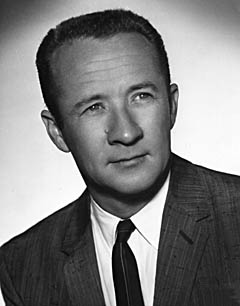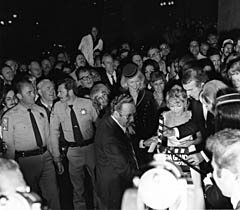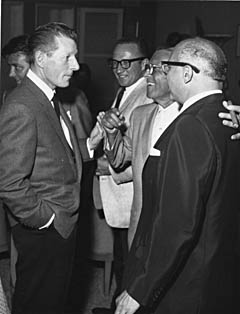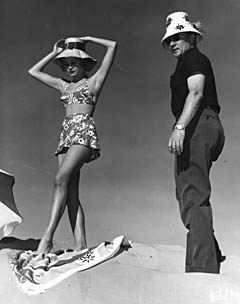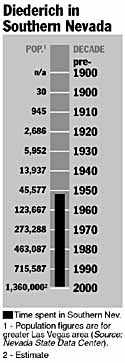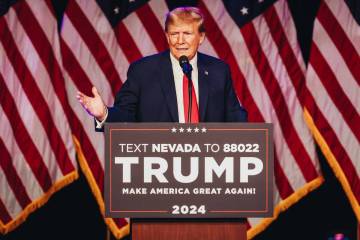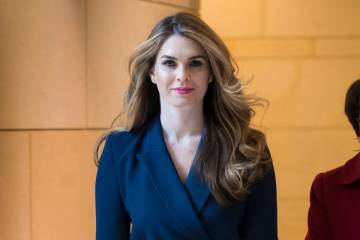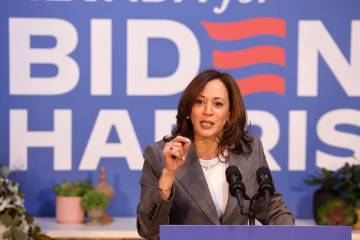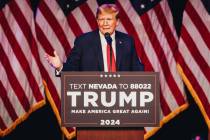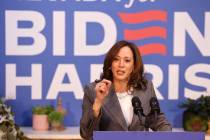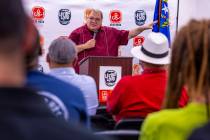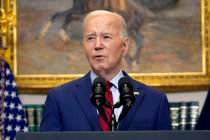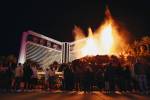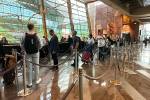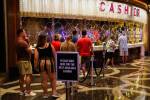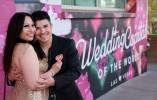Harvey Diederich
There were a lot of moving parts in the great postwar Las Vegas publicity engine, but it would certainly have stalled if not for the efforts of the Las Vegas News Bureau and resort publicists like Harvey Diederich, who touted his town from 1952 until his retirement in 1988.
"I think we were very instrumental in developing Las Vegas into an international destination during the 1950s and into the 1960s. I think through the efforts of all of us, we were able to call international attention to Las Vegas, basically through the appearances here of Hollywood personalities, and a lot of creative publicity." He pauses and a sly grin appears. "And there was creative use of showgirls."
One Valentine's Day, Diederich had a life-size playing card, a queen of hearts, made. The center was cut out, and a girl in a bathing suit was posed stepping through the hole. Like practically every publicity photo of the period, it was at poolside.
"But it got play," says Diederich.
In the leisure and resort industry that sprung up after World War II, publicists enjoyed an exalted status, sometimes even owning an interest in the property.
Harvey Diederich was born Feb. 8, 1920, in Chicago, the son of Walter and Minnie Diederich. He grew up in a Chicago suburb and served in the Army during World War II as a medic in the Pacific.
"We saw very little action," he says.
After the war, he enrolled in the journalism program at the University of Southern California and earned a bachelor's degree in 1950. He was named the department's outstanding male graduate that year.
But Diederich never became a newshound. His first publicity job after college was for the Los Angeles YMCA, where he rose to director of publicity within a few months.
In July of 1950, Diederich heard of a publicist's job in the ski resort town of Sun Valley, Idaho. The sleepy mountain town had become an internationally-known gathering place for the rich and famous largely because of the legendary Steve Hannagan, who invented the concept of promoting entire resort cities, and who hired Diederich.
It was a plum job, he recalls, but by 1952 he was ready for a change.
"Basically, I didn't want to go through another Sun Valley winter. I had instructions not to ski, because they were worried I would break a leg and not be able to do my job. So there was really no sense to being in Sun Valley in the winter if you couldn't ski."
Las Vegas publicity man Herb McDonald tipped Diederich to a job opening at The Last Frontier in Las Vegas. Diederich interviewed with general manager Bob Cannon and landed the job.
Hannagan had already come to Las Vegas and gone, leaving behind a formidable publicity machine, the Las Vegas News Bureau.
Don English, who came to Las Vegas in 1949 as a photographer for Hannagan, struck up lifelong friendship with Diederich.
"It was a very close relationship," said Diederich. "The News Bureau was the photographic arm and the writing aide to all the Las Vegas press agents in those days. We worked very, very closely, and we fed off each other. An idea would pop up, and we would discuss it and develop it together. It might originate with the News Bureau or an individual hotel, and the creativity blended both."
Diederich had been in Las Vegas only two years when he decided to move again.
"The Hannagan people asked me to come back and represent them in the Bahamas in 1954," he recalls. "It was not a happy experience." The problem was Diederich's breezy, informal Western style clashed with the starch and pomposity of the British-influenced islands. His tenure was brief, and he went from the islands to New York and a short stint with a public relations firm. In 1956, he came back to Las Vegas, where he had friends, good memories and a solid reputation.
"I came back to town without a job, driving a station wagon with a trailer with all our household goods, four children, a parakeet and a dog with a litter of pups."
But he immediately landed a job at the Hacienda, then moved to the Tropicana in 1957.
"The Tropicana was pure class in those days," he said. "We adopted the motto, 'The Tiffany of the Strip.' That phrase actually came from a magazine writer, but we borrowed it."
Diederich even wrung publicity from the 1956 presidential election. He and photographer English posed a showgirl poolside in a bathing suit. In her right hand, she held a cardboard campaign poster for Republican Dwight D. Eisenhower; in her left, a poster for Democrat Adlai Stevenson.
"Afterward, we wondered how are we going to tag this thing?" English remembers. "I suggested we name her Miss Bea Sure N. Vote."
Diederich admits that he didn't think there would be much interest in the cornball photo. "But it got a lot of play," he adds.
Cornball sold, Diederich learned, and so did screwball. Diederich recalls that one of his most successful pictures was taken in 1956 when he was working for the Hacienda which, at the time, had a golf course. After dark, a showgirl in a very short nightie was posed at the first hole, swinging at a ball. The caption was "Night-Tee-Time," and it was used by lecherous newspaper editors across the nation.
Holidays were prime time for themed cheesecake photos. One Thanksgiving, English recalls, Diederich ordered the Tropicana chef to carve an enormous ice sculpture of a turkey. A showgirl straddled its back, in an equestrian pose. The caption was "Cold Turkey."
"There were a lot of groans," laughs English, "but again, it worked."
Aside from cheesecake, the other staple of the Las Vegas publicity mill was celebrities.
Most celebrities were amenable to posing for the publicist's camera, especially those under contract with a Hollywood studio.
"In those days, the studios really owned the performer," said Diederich. "And when they wanted to go to Las Vegas, the studios probably welcomed the trip, but not unless they were completely cooperative with us."
When Ronald Reagan made his one and only Las Vegas appearance at The Last Frontier in 1954, Diederich and photographers marched him and Nancy around The Last Frontier Village, posing them on old cars and wagons, then sent them out to Lake Mead for a cruise on The Last Frontier's yacht, where they were photographed sunbathing, eating lunch and pretending to fish. Diederich recalls that the resulting pictures were a great hit with fan magazine editors.
The dawn of the television age in the early 1950s also offered some opportunities for free publicity, says Diederich.
Early TV programming managers were eager for "filler " material. The 1950s were a time when practically every celebrity in Hollywood was putting together a Las Vegas lounge act. Even Reagan, Marlene Dietrich and Mae West appeared. Despite their rather dubious news value, the Los Angeles stations would readily air film showing an aging West on stage surrounded by men in swimsuits.
One afternoon, English recalls, Diederich called and asked him to stop by the Tropicana for a brainstorming session. Harmonica player Johnny Puleo was opening, and Diederich wanted to shoot some footage for the TV stations. The female -- there had to be at least one -- was Felicia Atkins, a stunning showgirl.
Diederich and English made up the script as they went along.
They placed Puleo and Atkins on a couch. The musician made eyes at the showgirl. She was cold. He whipped out his harmonica, and began to blow a seductive tune. He rose and walked outside. She followed, entranced. He stepped into the shallow end of the pool, going deeper and deeper until he submerged. She followed until she, too, disappeared.
"That was the Pied Piper shot, and it was pretty hokey," laughs English. "But they used it."
Of course, not all of the publicity stunts were hatched by Diederich, who drops the names of his peers of the period, such as Gene Murphy at the Desert Inn and Bert Perry at the Flamingo.
Old-time Las Vegas publicists speak in reverential tones about Al Freeman, the legendary publicist for the Sands, whom Diederich describes as "a remarkable talent."
It was Freeman who engineered what is perhaps the most famous Las Vegas publicity shot in history -- the "floating" crap game. That picture, taken July 1, 1953, depicts a group of gamblers in swimsuits standing waist deep in the hotel pool around a crap table. It wasn't a prop, but a real crap table Freeman had removed from the casino.
English recalls Freeman as the kind of publicist who saw opportunities everywhere.
One evening in the early 1960s, comedian Red Skelton was well into his act on the Sands' Copa Room stage, when a lightning storm knocked out all power on the Strip. Skelton was unperturbed.
"He asked everybody to bring the candles from their tables forward and put them around the edge of the stage, like footlights, and he kept the show going."
Freeman called English and lamented that there had been no photographer. "I said, 'Listen, Al, can you get them to put the candles back up there, and we'll come on out and grab it.' " Freeman arranged the whole thing, and English raced back to the News Bureau and put the photo on the United Press International wire.
"The next morning, it was on the front page of the Los Angeles Mirror, two or three columns, with the caption 'The Show Must Go On.' They were mighty pleased."
Diederich worked at the Sahara between 1957 and 1961, when he returned to the Tropicana, where he remained until 1972. In 1973, he was hired to open the new MGM Grand (now Bally's). It should have been the capstone of his career.
In 1974, a reporter for the Los Angeles Times asked Diederich for assistance in developing a story about the idiosyncrasies of gamblers. Diederich introduced him to the vice president of casino operations, and left them to talk.
"He opened up to the reporter about some Arab gamblers we had in the hotel, and talked about their gambling, their excesses and so forth," Diederich said.
In so doing, the casino boss had broken a Las Vegas taboo -- never divulge any information about your customers' gambling habits. Diederich got the blame.
"It was my fault," he says quietly. "I should never have trusted the guy, but it seemed like an innocuous interview. It ended up costing me my job. It was tough to lose, because it was probably my best job in town. In the final analysis, I think it was a very positive story for the hotel. It certainly won the admiration of Jews around the world, because we had beaten these Arabs out of millions of dollars. It was like revenge."
Diederich ended his career as a Las Vegas publicity man at the Union Plaza, where he served from 1980 to 1988.
Diederich was disappointed when the Chamber of Commerce turned over the operation of the News Bureau to the Las Vegas Convention and Visitors Authority, which spends far more on advertising than it does on publicity, and cut back the staff of the News Bureau drastically.
"Publicity far, far exceeds the value of advertising," he says. "Basically, it's more believable."
Part I: The Early Years
Part II: Resort Rising
Part III: A City In Full



